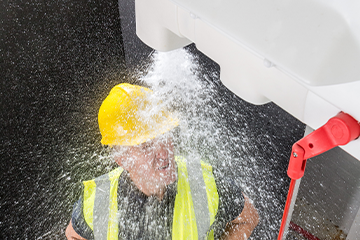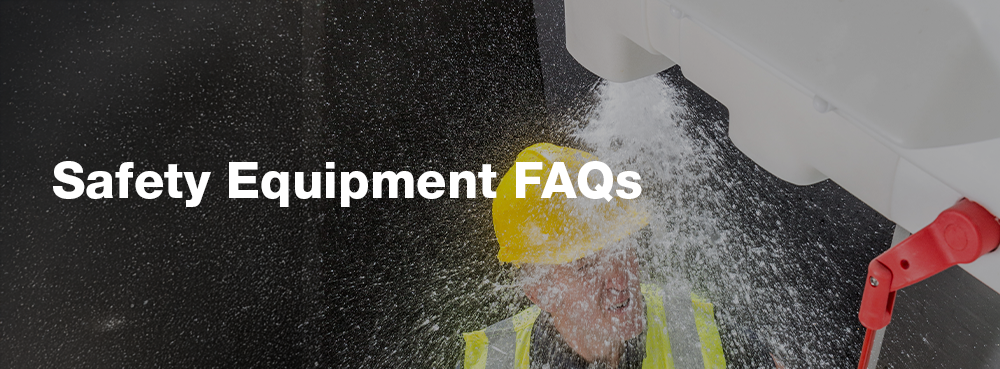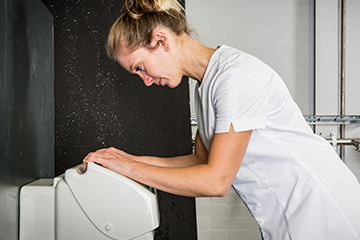Enquiry List () (0)
- 29 Sept 2025

Frequently Asked Questions for Emergency Safety Showers and Eye Washes

At Hughes Safety Showers, we understand that when it comes to emergency safety showers and eye wash stations, having clear and reliable information is vital to ensuring workplace safety and compliance. This FAQ guide addresses the most common questions around the selection, maintenance, installation, and regulatory requirements of safety showers and eye wash units. Whether you're managing a site or responsible for safety equipment, this resource is designed to provide practical answers and expert advice, helping you maintain a safe environment and meet the necessary standards with confidence.
- How can I prevent legionella growth in safety showers and eye wash stations?
Legionella bacteria growth can be effectively controlled by regular maintenance.
This includes monthly inspections of water storage tanks, quarterly cleaning and disinfection of shower heads, nozzles, and strainers, and flushing the system every six months to purge stagnant water.
These practices help maintain hygienic and safe water systems in self-contained safety showers or eyewash units. For more information visit our dedicated page for managing bacteria growth.
- How often should water preservative be replaced in self-contained eye washes and safety showers?
Water preservative should be replaced every 120 days or after each use to ensure the water remains safe and uncontaminated for emergency use.
- How often should eye wash diffusers be replaced?
To maintain hygiene and optimal functionality, eye wash diffusers should be replaced every six months.
Check out the spare parts page for details of the Hughes eye wash diffuser kits complete with a key to assist with replacement.
- What is the proper way to dispose of contaminated water from safety showers and eye wash units?
Contaminated water must be disposed of safely to prevent environmental contamination. Measures should be taken to ensure harmful water does not enter natural watercourses. It is advisable to consult your local regulatory authority or environmental agencies for guidance and to include this in your site’s risk assessment.
- How do I select the correct model of safety shower or eye wash station for my workplace?
Selecting the appropriate safety equipment depends on several operational factors including hazard type, location, water supply, and user access. Reviewing key considerations such as these before purchase ensures compliance and safety effectiveness.
Click here for six important factors to consider before purchasing a safety shower.
- Are safety showers and emergency eye wash stations legally required, and what standards apply?
While laws do not explicitly state that sites must have a safety shower or eyewash on their site, there are other relevant laws that site managers must adhere to with regards to safety equipment.
According to many international laws, such as regulations defined by OSHA, HSE, COSHH to name a few, site managers are required to carry out a thorough risk assessment to identify potential hazards. The result of these risk assessments then determine what safety equipment is necessary to mitigate harm caused in an accident.
Failure to provide the appropriate equipment could result in non-compliance and therefore liability in the event of an accident. Non-compliance can result in costly compensation paid to the casualty as well as significant fines by local authorities. For OSHA these fines can be unlimited for repeated cases of negligence. Relevant safety standards include ANSI Z358.1 (U.S.) and EN 15154 (Europe), which set guidelines for design, performance, and installation.
View a full breakdown of ANSI and EN requirements for safety showers and eyewashes.
- What maintenance and testing are necessary to keep safety showers and eye washes compliant?
Regular testing and maintenance are crucial. Weekly activation and visual inspection of safety showers to verify flow and operation is recommended to meet compliance and ensure reliability during emergencies. Additionally, units should be annually serviced by an engineer for a thorough inspection and to identify any parts that may need repair or replacement.
Explore more about the Importance of Weekly Activation of Safety Showers and Hughes’ servicing options.
- Do safety showers and eye wash stations need to maintain a specific water temperature?
Yes, safety standards require the water temperature to be within a comfortable range to prevent additional injury during use. ANSI standards specify 16°C to 38°C, while EN standards specify 15°C to 37°C as acceptable temperature ranges.
Read more about the Importance of Tepid Water in emergency safety equipment.
- Do safety showers and eye wash stations need potable water?
Yes. Potable water (CAT1) is specified by safety standards for use in emergency safety equipment.
Water/liquids of a lower fluid classification can contain various contaminants such as toxic chemical waste, pathogenic organisms, and even fecal matter. Such contaminants pose an additional risk of infection to a casualty and should not be used to flush chemical burns on the eyes or skin.
Read more about the Importance of Potable Water here.
- Where should safety showers and eye washes be located on site?
Safety equipment should be installed within 10 seconds walking distance from the hazard, on the same level as the hazard, and placed free from obstructions to ensure rapid access in an emergency.
For a full specification of where you should position your safety equipment, in accordance to regulatory standards, click here.
- How can I arrange the installation of safety showers and eye wash stations?
Installation should be performed by qualified professionals. For mainland UK, Hughes Safety Showers offers comprehensive servicing and installation assistance to ensure units are correctly installed and compliant with safety standards.
Enquire with our service team today.
Do you have a query not listed above? Our team at Hughes are on-hand to offer expert advice, ensuring you have peace of mind and confidence in your site safety. Contact Hughes today through our online enquiry form or our live chat through our online enquiry form or our live chat.










